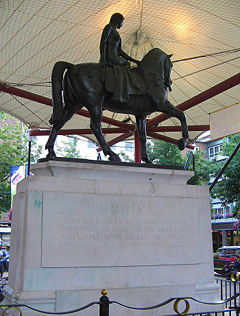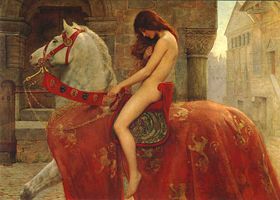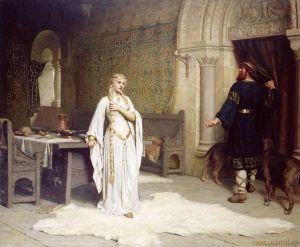Lady Godiva
Godiva (or Godgifu) (fl. 1040-1080) was an Anglo-Saxon noblewoman who, according to legend, rode naked through the streets of Coventry in England in order to gain a remission of the oppressive toll imposed by her husband on his tenants. The name "Peeping Tom" for a voyeur comes from later versions of this legend in which a man named Tom watched her ride and was struck blind or dead.
The historical figure
Lady Godiva was the wife of Leofric (968–1057), Earl of Mercia. Her name occurs in charters and the Domesday survey, though the spelling varies. The Old English name Godgifu or Godgyfu meant "gift of God"; Godiva was the Latinized version. Since the name was a popular one, there are contemporaries of the same name.[1][2]
If she is the same Godgifu who appears in the chronicles of Ely, Liber Eliensis (end of 12th century), she was a widow when Leofric married her. Both Leofric and Godiva were generous benefactors to religious houses. In 1043 Leofric founded and endowed a Benedictine monastery at Coventry.[3] Writing in the 12th century, Roger of Wendover credits Godiva as the persuasive force behind this act. In the 1050s, her name is coupled with that of her husband on a grant of land to the monastery of St Mary, Worcester and the endowment of the minster at Stow St Mary, Lincolnshire.[4][5] She and her husband are commemorated as benefactors of other monasteries at Leominster, Chester, Much Wenlock and Evesham.[6]
The manor of Woolhope in Herefordshire, along with three others, was given to the cathedral at Hereford before the Norman Conquest by the benefactresses Wulviva and Godiva–traditionally held to be Lady Godiva and her sister. The church there has a 20th century stained glass window depicting them.[7]
Her mark, di Ego Godiva Comitissa diu istud desideravi, appears on a charter purportedly given by Thorold of Bucknall to the Benedictine monastery of Spalding. However, this charter is considered spurious by many historians.[8] Even so it is possible that Thorold, who appears in the Domesday Book as sheriff of Lincolnshire, was her brother.
After Leofric's death in 1057, his widow lived on until sometime beyond the Norman Conquest of 1066. She is mentioned in the Domesday survey as one of the few Anglo-Saxons and the only woman to remain a major landholder shortly after the conquest. By the time of this great survey in 1086, Godiva had died, but her former lands are listed, although now held by others.[9] Thus, Godiva apparently died between 1066 and 1086.[1]
The place where Godiva was buried has been a matter of debate. According to the Evesham Chronicle, she was buried at the Church of the Blessed Trinity at Evesham,[10] which is no longer standing. But, according to the authoritative account in the Oxford Dictionary of National Biography, "There is no reason to doubt that she was buried with her husband at Coventry, despite the assertion of the Evesham chronicle that she lay in Holy Trinity, Evesham."[1]
William Dugdale (1656) states that a window with representations of Leofric and Godiva was placed in Trinity Church, Coventry, about the time of Richard II.
The legend

According to the popular story,[12][13] Lady Godiva took pity on the people of Coventry, who were suffering grievously under her husband's oppressive taxation. Lady Godiva appealed again and again to her husband, who obstinately refused to remit the tolls. At last, weary of her entreaties, he said he would grant her request if she would strip naked and ride through the streets of the town. Lady Godiva took him at his word and, after issuing a proclamation that all persons should keep within doors and shut their windows, she rode through the town, clothed only in her long hair. Only one person in the town, a tailor ever afterwards known as Peeping Tom, disobeyed her proclamation in one of the most famous instances of voyeurism.[14] In the story, Tom bores a hole in his shutters so that he might see Godiva pass, and is struck blind.[15] In the end, Godiva's husband keeps his word and abolishes the onerous taxes.
The oldest form of the legend has Godiva passing through Coventry market from one end to the other while the people were assembled, attended only by two knights.[16] This version is given in Flores Historiarum by Roger of Wendover (died 1236), a somewhat gullible collector of anecdotes, who quoted from an earlier writer. The later story, with its episode of "Peeping Tom", appeared first among 17th century chroniclers.
At the time, it was customary for penitents to make a public procession in only their shift, a sleeveless white garment similar to a contemporary slip. Thus, some scholars speculate, the Godiva legend may have originated from a trip through town as a penitent, in her shift. Godiva's story may have passed into folk history to be recorded in a romanticized version. Another theory has it that Lady Godiva's "nakedness" may refer to her riding through the streets stripped of her jewellery, the trademark of her upper class rank. However, both these attempts to reconcile known facts with legend are largely speculativ; there is no known use of the word "naked" in the era of the earliest accounts to mean anything other than "without any clothing whatsoever."[17]
Moreover, there is no trace of any version of the story in sources contemporary with Godiva, a story that would certainly have been recorded even in its most tame interpretations. Additionally, with the founding of Coventry circa 1043, there was little opportunity for the city to have developed to an extent that would have supported such a noble gesture. Lastly, the only recorded tolls were on horses. Thus, it remains doubtful whether there is any historical basis for the famous ride.
Like the story of Peeping Tom, the claim that Godiva's long hair effectively hid her nakedness from sight is generally believed to have been a later addition (cf. Rapunzel). Certain other thematic elements are familiar in myth and fable: the resistant Lord (cf. Esther and Ahasuerus), the exacted promise, the stringent condition and the test of chastity. Even if Peeping Tom is a late addition, his being struck blind demonstrates the closely knit themes of the violated mystery and the punished intruder (cf. Diana and Actaeon).
Popular culture
- The Godiva Procession, a commemoration of the legendary ride instituted on May 31, 1678, as part of Coventry fair, was celebrated at intervals until 1826. From 1848 to 1887, it was revived and continues into the 21st century as part of the Godiva Festival.
- The wooden effigy of Peeping Tom which, from 1812 until World War II, looked out on the world from a hotel at the northwest corner of Hertford Street, Coventry, can now be found in Cathedral Lanes Shopping Centre. It represents a man in armour and was probably an image of Saint George. Nearby, in the 1950s rebuilt Broadgate, an animated Peeping Tom watches over Lady Godiva as she makes her hourly ride around the Godiva Clock.[18]
- From the mid 1980s a Coventry resident, Pru Porretta, has adopted a Lady Godiva role to promote community events and good works in the city. In 1999 Coventry councillors considered eliminating Godiva from the city's public identity.[19] As of 2005, Porretta retains the status of Coventry's unofficial ambassador. Each September Poretta marks the occasion of Lady Godiva's birthday by leading a local pageant focusing on world peace and unity known as The Godiva Sisters. In August 2007, the Godiva Sisters was performed in front of 900 delegates from 69 countries attending the World Council for Gifted and Talented Children Biennial Conference held at the University of Warwick.
- Godiva was immortalized anew in the poem Godiva by Alfred, Lord Tennyson.
- In Cockney rhyming slang a £5 note (or fiver) is referred to as a Lady Godiva.
Engineering mascot
In many[attribution needed] university engineering faculties, military engineering corps and other engineering organisations, Lady Godiva is regarded as a mascot and called the "Patron Saint of Engineers" or "Goddess of Engineering". The origin is unclear, although it probably developed in Britain, where several early engineering schools were founded during the industrial revolution. The practice migrated to North America through Canadian schools, such as the University of Toronto which today holds an annual "Godiva Week" in January consisting of events intended to engender school spirit. By the mid-20th century, the practice of engineering organisations associating themselves with Lady Godiva was well established in the United States.
A particular tradition associated with this is that of drinking songs, which make reference to Lady Godiva, particularly Godiva's Hymn.
Historically, certain college organisations staged an annual "Godiva Ride" in which a naked female (or a costumed male) rode a horse across campus.[20] This practice may have declined with the advent of modern feminist attitudes.[21]
Music
Several popular songs make contemporary usage of the Lady Godiva image. These include:
- The Velvet Underground's "Lady Godiva's Operation" on their 1968 LP, White Light/White Heat, referring to a transwoman who dies at the hands of her surgeons during a sexual reassignment-turned-lobotomy.
- Peter and Gordon's "Lady Godiva" (1966 in the UK, 1967 in the US) is about a woman who becomes involved in a burlesque show. Like Coventry's Lady Godiva, the Lady Godiva of the song has long flowing hair that covers her body. However, the song has her hair cut as a condition to her performing in the burlesque show.
- Grant Lee Buffalo's song "Lady Godiva and Me" from their 1994 album, Mighty Joe Moon, includes references to Peeping Tom.
- Dr. Hook & The Medicine Show recorded the song "Hey, Lady Godiva".
- Mother Love Bone recorded a song, "Lady Godiva Blues", on their 1992 self-titled album.
- Queen's "Don't Stop Me Now" sees Freddie Mercury "passing by like Lady Godiva".
- Simply Red recorded "Lady Godiva’s Room" on their 1992 EP Montreux
- Aerosmith's song "My Girl" from their album, Pump, contains the line, "My girl's a Lady Godiva."
- In Peter Gabriel's song "Modern Love" off his self-titled 1977 album, he states "For Lady Godiva I came incognito".
- In the theme song to the situation comedy Maude, the opening lines were, "Lady Godiva was a Freedom Rider,/ She didn't care if the whole world looked..."
- Boney M's song "Lady Godiva" was released in 1993 on the album Boney M. More Gold.
Opera
The plot of the Mascagni's opera Isabeau is based on the story of Lady Godiva.
Literature
- In 1939, Dr. Seuss wrote a short illustrated novel entitled The Seven Lady Godivas: The True Facts Concerning History's Barest Family, based on the character.
- Lady Godiva is mentioned in Sylvia Plath's poem "Ariel".
- Lady Godiva also appears in Ezra Pound's poem "Nicotine".
- Lady Godiva also appears in "Godiva", a poem by Sir Alfred Tennyson.
Television
- In the Charmed episode "The Bare Witch Project", a student in Magic School accidentally conjures Lady Godiva and Lord Dyson out of a history book. Later, Phoebe, inspired by Lady Godiva, decides to ride naked through a crowded street in support of women's liberation.
- In an episode "The Godiva Affair" of the British sitcom Dad's Army, women in the town of Walmington-on-Sea compete for the part of Lady Godiva to head a carnival procession in the town, ultimately performed by Elizabeth, the wife of Captain Mainwaring, causing him to collapse in astonishment and shame.
- The Gorgeous Ladies of Wrestling featured a character named Godiva who rode to the ring on a horse and wore a sheer bodysuit.
- The Histeria! episode "Tribute to Tyrants" featured a sketch about the legend of Lady Godiva, portrayed by the World's Oldest Woman.
- In one Frasier episode, a girl is wearing a Lady Godiva costume.
- In another Frasier episode, the character of Maris was involved in an unfortunate chemical bonding incident while performing a Lady Godiva impression on a horse saddle her husband Niles Crane had bought her.
- The Maude theme song begins with the words, "Lady Godiva was a freedom rider; she didn't care if the whole world looked!".
- In the Blackadder Goes Forth episode "Private Plane", Captain Blackadder (Rowan Atkinson) describes the Royal Flying Corps as "the biggest show-offs since Lady Godiva entered the royal enclosure at Ascot claiming she had literally nothing to wear".
- In the Round the Twist episode "Linda Godiva", Linda helps Pete win a cross-country horse race by being invisible, she is later turned visible and is seen riding the horse naked.
- In the first episode of The Vicar of Dibley, several characters reminisce about when Letitia Cropley rode through Dibley stark naked in a Lady Godiva reenactment.
- In the Seinfeld episode "The Apology", Jerry's girlfriend regularly walks around in his apartment naked, and at one point he refers to her as "Lady Godiva".
- The title of Canadian comedy-drama series Godiva's is an allusion to Lady Godiva.
- In an episode of Time Squad Larry showed Otto videos of previous missions and in one of these missions Lady Godiva was riding her horse naked while Tuddrussel ran after her, trying to persuade her to wear some clothes.
- In an episode of Spin City, the mayor's rebellious daughter rides naked though central park in protest.
- In an episode of The West Wing, Josh Lyman refers to Amy as Lady Godiva after she asks him to make changes to an international treaty that would criminalize all prostitution rather than just forced prostitution.
Film
From 1911 onward, several films have been made with the title "Lady Godiva".[22] These include: Lady Godiva Rides Again (1951) starring English actress Diana Dors[23] and Lady Godiva (1955) starring Irish actress Maureen O'Hara.[24]
A 1949 Three Stooges short film, The Ghost Talks, featured one of the boys playing Peeping Tom in a slapstick send-up of the Lady Godiva legend. Inspired by an encounter between the stooges and a haunted, empty suit of armour occupied by Tom's spirit, the film changes key elements of the legend, eliminating Tom's blindness as his penalty and inventing a relationship between the tailor and the Lady. The Stooges act out the ghost's narrative of the events of the famous day in costumes based on the clothing of a period many years later than the life of the historic Godiva.
In the 1988 film High Spirits with Peter O'Toole, the character Eamon, when trying to get two of the castle's female employees to pose as ghosts, tells Patricia he can see her as a mermaid, or the 'Lady Godiva'.
Notes
- ↑ 1.0 1.1 1.2 Ann Williams, ‘Godgifu (d. 1067?)’, Oxford Dictionary of National Biography, Oxford University Press, Sept 2004; online edn, Oct 2006 accessed 18 April 2008
- ↑ "Lady Godiva, the book, and Washingborough", Lincolnshire Past and Present, 12 (1993), pp.9–10.
- ↑ Anglo-Saxons.net, S 1226
- ↑ Anglo-Saxons.net, S 1232
- ↑ Anglo-Saxons.net, S 1478
- ↑ The Chronicle of John of Worcester ed. and trans. R.R. Darlington, P. McGurk and J. Bray (Clarendon Press: Oxford 1995), pp.582–583
- ↑ flickr.com
- ↑ Anglo-Saxons.net, S 1230
- ↑ K.S.B.Keats-Rohan, Domesday People: A prosopography of persons occurring in English documents 1066–1166, vol.1: Domesday (Boydell Press: Woodbridge, Suffolk 1999), p.218
- ↑ "Countess Godiva", Cecilia Parsons, 1999, 2000, revised by John Collier, 2004
- ↑ Douglas, Alton (February 1991). Coventry: A Century of News. Coventry Evening Telegraph. ISBN 0902464361.
- ↑ Joan Cadogan Lancaster. Godiva of Coventry. With a chapter on the folk tradition of the story by H.R. Ellis Davidson. Coventry [Eng.] Coventry Corp., 1967. OCLC 1664951
- ↑ K. L. French, ‘The legend of Lady Godiva’, Journal of Medieval History, 18 (1992), 3–19
- ↑ Lady Godiva, Historic-UK.com
- ↑ "The Historical Godiva", Octavia Randolph
- ↑ "Lady Godiva (Godgifu)", Flowers of History, University of California San Francisco
- ↑ The Naked Truth, BBC News 2001
- ↑ Coventry Now & Then: Hertford Street from Broadgate
- ↑ "Don't Drop Lady Godiva", Coventry & Warwickshire News, 15 November 1999
- ↑ Facts, figures, myths, oddities, people, places and traditions that help define the University of Alberta, Charlene Rooke and Rick Pilger, University of Alberta New Trail Magazine, November 1998
- ↑ "Students scrutinize Lady Godiva ride", CBC Archives, February 4, 1990
- ↑ http://www.imdb.com/find?s=all&q=lady+godiva&x=14&y=6 'Lady Godiva' on imdb
- ↑ Lady Godiva Rides Again - Trailer - Cast - Showtimes - New York Times
- ↑ Lady Godiva - Trailer - Cast - Showtimes - New York Times
See also
- Asteroid 3018 Godiva, named after Lady Godiva
- Godiva Chocolates, a chocolate company named after and featuring artwork of Godiva on their boxes
- Lady Godiva syndrome
- Public nudity
- The Seven Lady Godivas, an early Dr. Seuss book
- Nudity and protest
External links
- Lady Godiva, the website of the women's sports team
- Cecilia Parsons, "Countess Godiva", 1999, revised 2004: biography and developing legend
- BBC News – the unearthing of a stained glass window identified with Lady Godiva
- James Grout: Lady Godiva, part of the Encyclopædia Romana
- How Lady Godiva Got a Tax Break
Credits
New World Encyclopedia writers and editors rewrote and completed the Wikipedia article in accordance with New World Encyclopedia standards. This article abides by terms of the Creative Commons CC-by-sa 3.0 License (CC-by-sa), which may be used and disseminated with proper attribution. Credit is due under the terms of this license that can reference both the New World Encyclopedia contributors and the selfless volunteer contributors of the Wikimedia Foundation. To cite this article click here for a list of acceptable citing formats.The history of earlier contributions by wikipedians is accessible to researchers here:
The history of this article since it was imported to New World Encyclopedia:
Note: Some restrictions may apply to use of individual images which are separately licensed.


